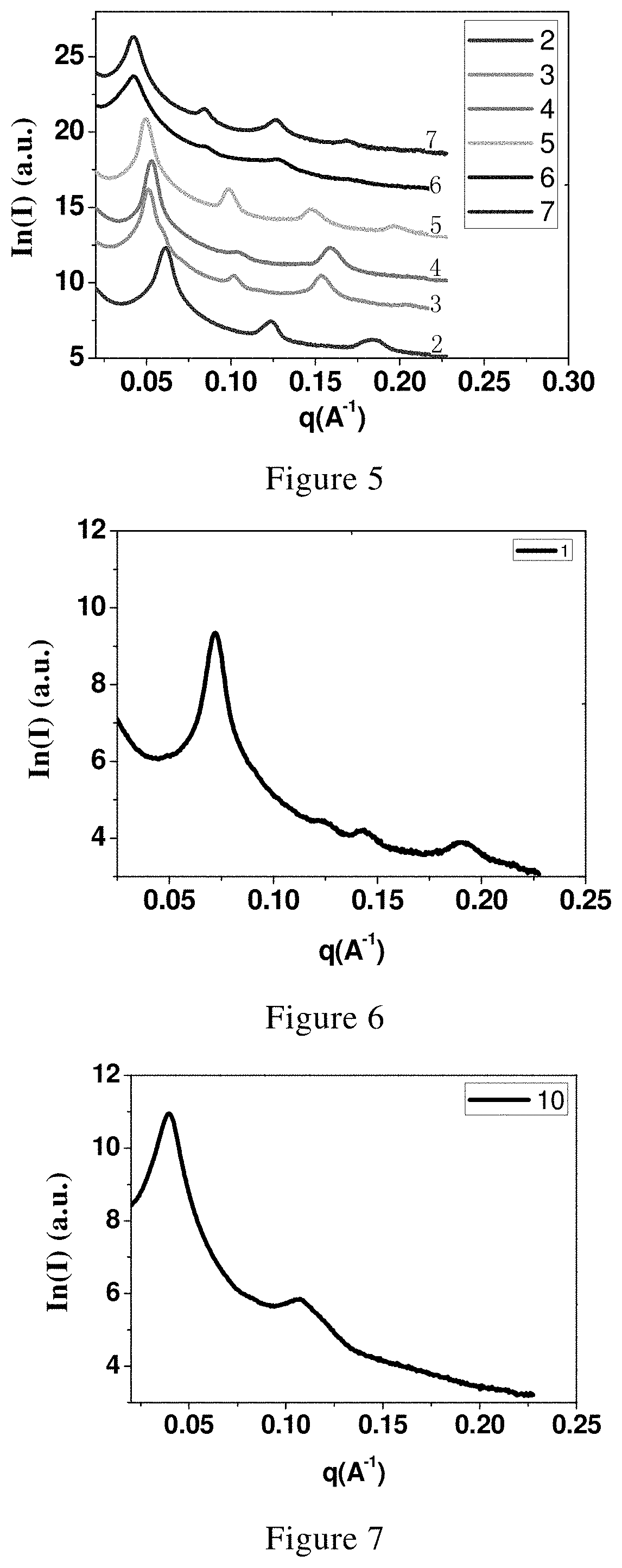Rapid self-assembled small-sized block polymer material with low quenching temperature and the preparation and application thereof
a self-assembling, small-sized block technology, applied can solve the problems of affecting the application of the technology in the field of materials, and affecting the success of the photolithography technology to reach the 10 nm scal
- Summary
- Abstract
- Description
- Claims
- Application Information
AI Technical Summary
Benefits of technology
Problems solved by technology
Method used
Image
Examples
example 1
the Preparation of Class a Block Copolymer PS-PPDFMA-3-21 (R1═CH3, R2═C12H10F15, R3=None)
[0161]3 ml styrene
[0162]
and 30 ml THF were treated with MgBu2 solution (1M in hexane) at 40° C. for 0.5 h, and then transferred to the reaction flask. The reaction flask was returned to room temperature, and stirred to be uniform, and then placed into a cold bath at −40° C. for 15 min. 0.5 ml sec-BuLi (1M in hexane) was added, and kept at −40° C. and reacted for 15 min. The temperature of the dried modified methacrylate monomer A quenched at low temperature (1.6 g) was reduced to −30° C., and then the obtained was dropped into the reaction system containing styrene, keeping at −40° C. and reacted for 30 min. The product was precipitated in ethanol to give 3.5 g of white solid.
[0163]FIG. 1 is a 1H-NMR spectrum of the block copolymer PS-PPDFMA-3-21.
[0164]It can be seen from FIG. 1 that the characteristic H peaks of the PS block and the PPDFMA block are corresponding to the structures indicated abo...
example 2
the Reparation of Class a Block Copolymer PS-PPDFMA-3-46 (R1═CH3, R2═C12H10F15, R3=None)
[0170]2 ml styrene and 30 ml THF were treated with MgBu2 solution (1M in hexane) at 40° C. for 0.5 h, and then transferred to the reaction flask. The reaction flask was returned to room temperature, and stirred to be uniform, and then placed into a cold bath at −50° C. for 15 min. 0.5 ml sec-BuLi (1M in hexane) was added and kept at −50° C. and reacted for 15 min. The temperature of the dried modified methacrylate monomer A (1.6 g) was reduced to −30° C., and then the obtained was dropped into the reaction system containing styrene, keeping at −50° C. and reacted for 30 min. The product was precipitated in ethanol to give 2.6 g of white solid in 90% yield.
[0171]The 1H-NMR spectrum of the block copolymer PS-PPDFMA-3-46 is similar to FIG. 1.
[0172]The GPC results of the block copolymer PS-PPDFMA-3-46 are similar to those of PS-PPDFMA-3-21, and the number average molecular weight thereof is 12500 and...
example 3
the Preparation of Class a Block Copolymer PS-PPDFMA-3-47 (R1═CH3, R2═C12H10F15, R3=None)
[0176]1.5 ml styrene and 30 ml THF were treated with MgBu2 solution (1M in hexane) at 40° C. for 0.5 h, and then transferred to the reaction flask. The reaction flask was returned to room temperature, and stirred to be uniform, and then placed into a cold bath at −50° C. for 15 min. 0.5 ml sec-BuLi (1M in hexane) was added and the solution rapidly became orange-red, keeping at −50° C. and reacted for 15 min. The temperature of the dried modified methacrylate monomer A (1.6 g) was reduced to −30° C., and then the obtained was dropped into the reaction system containing styrene, keeping at −50° C. and reacted for 30 min. The product was precipitated in ethanol to give 2.2 g of white solid.
[0177]The 1H-NMR spectrum of the block copolymer PS-PPDFMA-3-47 is similar to FIG. 1.
[0178]The GPC analysis shows the number average molecular weight of the block copolymer PS-PPDFMA-3-47 is 11300 and PDI thereof...
PUM
| Property | Measurement | Unit |
|---|---|---|
| glass transition temperature | aaaaa | aaaaa |
| temperature | aaaaa | aaaaa |
| temperature | aaaaa | aaaaa |
Abstract
Description
Claims
Application Information
 Login to View More
Login to View More - R&D
- Intellectual Property
- Life Sciences
- Materials
- Tech Scout
- Unparalleled Data Quality
- Higher Quality Content
- 60% Fewer Hallucinations
Browse by: Latest US Patents, China's latest patents, Technical Efficacy Thesaurus, Application Domain, Technology Topic, Popular Technical Reports.
© 2025 PatSnap. All rights reserved.Legal|Privacy policy|Modern Slavery Act Transparency Statement|Sitemap|About US| Contact US: help@patsnap.com



